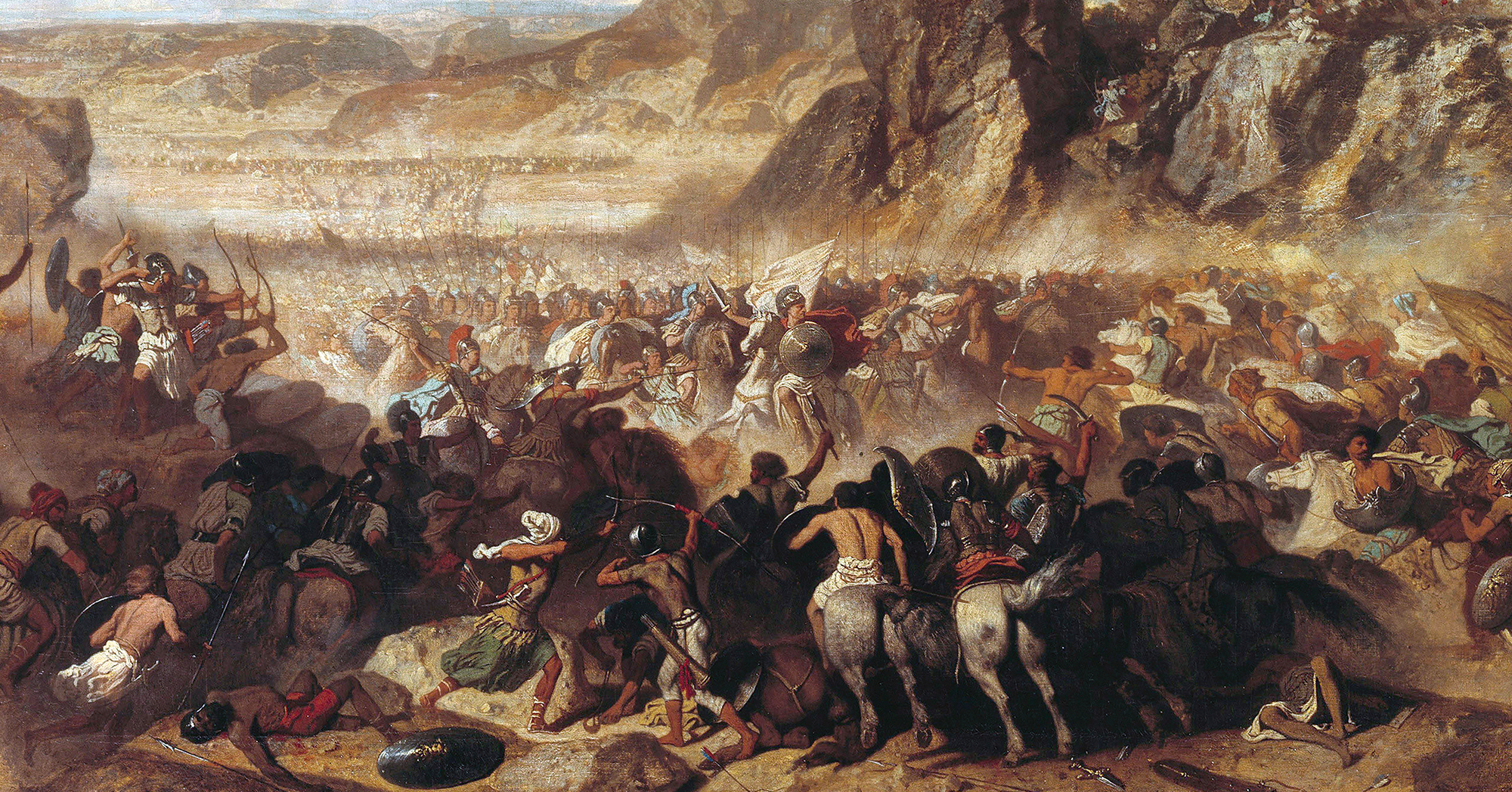“The sea! The sea!” The jubilant cry from thousands of throats swelled as the ragged line of soldiers ascended the summit. Those behind them on the mountainside ran forward, driving baggage animals and horses at full speed. Assuming enemies were attacking the front of the column, the rearguard commander rushed forward with the cavalry to give support—but he encountered no foes. Instead, he saw the expanse of water stretching out before them and was similarly moved. These stalwart men of war, who had suffered and conquered all manner of hardships and danger, embraced each other tearfully with shouts of joy. Here, at long last, was their road home.
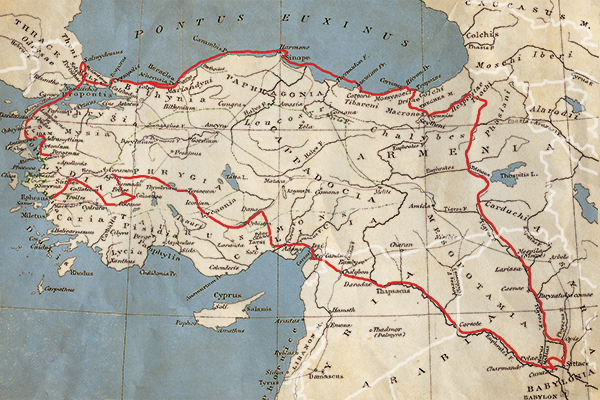
Known to history as the Ten Thousand, these Greeks had marched across barren, waterless steppes and through snow-choked mountain passes. Along the way they’d fought a succession of enemies and suffered various maladies, including battle wounds, frostbite, malnutrition, thirst and illness. Their extraordinary journey is related in Anabasis (Greek for “upward journey”), by Xenophon, a professional soldier who was the rearguard commander mentioned above and traversed the same arduous road. The Greeks’ two-year (401–399 BC), nearly 3,000-mile campaign—from Ephesus on the Aegean Sea east to the heart of the Persian empire, north to the shore of the Black Sea and back west to Byzantium (present-day Istanbul)—is a remarkable narrative of endurance and discipline.
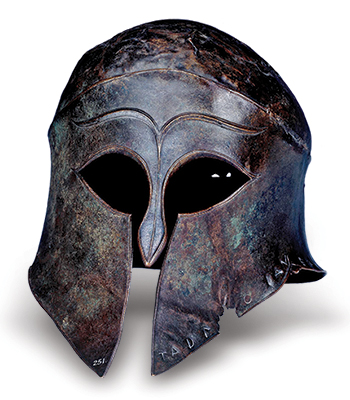
By 401 BC Greece lay bruised and battered from 27 years of civil war among Spartans, Athenians and their respective allies. The Peloponnesian War had ended, yet a fighting spirit remained. Enterprising mercenaries from across the Hellenic world found an outlet for their martial talents within the sprawling Persian empire to the east.
Following the 404 BC death of Persia’s King Darius II, tensions flared between his sons Artaxerxes and Cyrus. Although Cyrus was favored by his mother, the line of succession fell to his older brother, who became King Artaxerxes II. Darius had given Cyrus a consolation prize as satrap of and commander of Persian forces in the Anatolian provinces of Lydia, Phrygia and Cappadocia. Discontented with his share, Cyrus plotted to assassinate his recently coronated sibling. Exposed but spared from execution, thanks to his mother’s tearful intercession, Cyrus was allowed to return to his post. Having escaped punishment, however, Cyrus became even more determined to unseat his brother. Resolving to stage a coup, he began a covert military buildup within his territory, all the while assuring the royal court he was gathering troops to drive the hostile tribes of Pisidia from the Taurus Mountains.
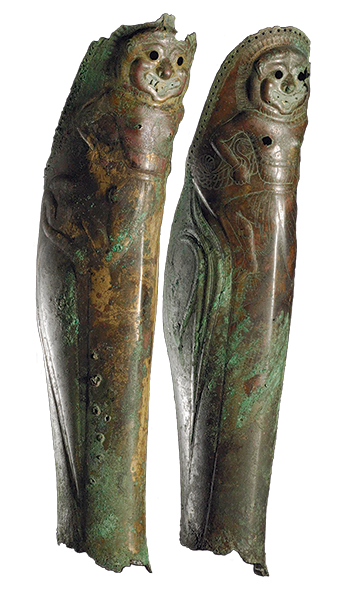
Reckoning his own troops (estimated at 20,000 men) insufficient to go up against the Persian army, Cyrus sent out agents to enlist foreign soldiers. He sought more than numerical superiority. Greek hoplites—armor-clad heavy infantrymen armed with spears and shields—had long been in demand by Eastern potentates for their battlefield effectiveness. The promise of pay and the opportunity for military adventure was enough to draw more than 10,000 of these troops to serve Cyrus, although he concealed his true purpose from the hirelings. Joining the hoplites were Thracian peltasts (skirmishers) and Cretan archers. Ultimately, given the size of the military buildup around his Lydian capital at Sardis, Cyrus’ motive became obvious, and Artaxerxes mobilized his own forces in response.
Marching his army southeast from Sardis, Cyrus set his sights on the eastern Anatolian pass known as the Syrian Gates, through which he would thrust at the heart of his brother’s empire. He pushed his troops hard. Such haste was a necessity, dictated by the barren terrain they traversed, in which food, fodder and water were scarce. Cyrus also hoped to exploit the Achilles’ heel of the Persian empire. While enormously strong in the extent of its territory, population and military power, it suffered from weak lines of communication and wide dispersal of its forces. Speed offered the best chance of victory. The faster Cyrus arrived, the less prepared Artaxerxes would be to meet him. Any delays could prove fatal to the expedition.
Although Cyrus concealed his intentions from the Greek soldiers, the column’s eastward trajectory made it clear he had grander designs than driving a few tribesmen from the hills. At Tarsus the mercenaries collectively refused to go any farther, as battle against the entire Persian army was not the job for which they’d signed on. Their protest halted the march for a critical 20 days. Cyrus managed to get them moving again with promises of higher pay. Still, he didn’t formally reveal his plan to claim the throne until the army reached Thapsacus on the Euphrates River. Further bribery on Cyrus’ part convinced the Greeks to stay the course.
Marching southeast along the river toward Babylon (present-day Baghdad), Cyrus anticipated a clash with Artaxerxes’ forces each passing day. Finally, scouts reported the king’s presence at Cunaxa, north of the Persian capital. The Greeks anchored the right of Cyrus’ line along the river, while his provincial troops formed up on the left. Cyrus held the center with his personal cavalry. His troops watched as a great dust cloud raised by Artaxerxes’ far larger force rolled across the plain toward them, its approaching shadow lit with flashes of bronze armor and gleaming spearpoints.
As the armies closed, the Greeks proved their mettle by charging and routing the Persians facing them. On Cyrus’ left, however, the king’s ranks stretched well beyond his own lines, posing a threat of encirclement. Like his brother, Artaxerxes led from the center—the customary position of Persian commanders. Seeing the king on the field and gambling on swift victory, Cyrus charged and broke through the screen of troops in front of Artaxerxes. He managed to wound his brother in the chest, knocking him from his horse. But in the process he overextended himself and was surrounded. Struck beneath the eye by a javelin, Cyrus dropped to the ground, his dreams of power bleeding into the dust. According to the ancient Greek historian Ctesias, in his work Persica, Cyrus survived the injury, and companions carried him from the field alive. Attacked again, Cyrus suffered a spear wound to the leg and died after striking his head on a stone as he fell. At that his army fled, saving themselves as best they could.
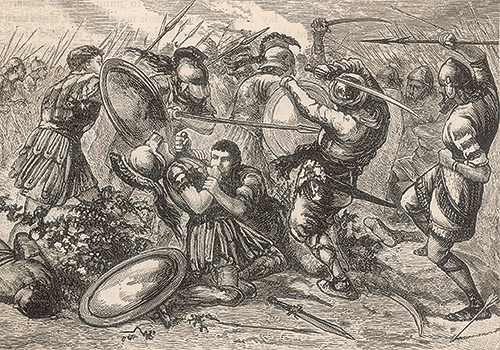
Oblivious to the dire events on the front lines, the Ten Thousand continued to pursue the Persians who had broken and fled on Artaxerxes’ left. When they returned to mop up any stragglers, they found their enemies gone and their camp plundered. There they passed a hungry, uncomfortable night with no news of the fateful battle.
In the morning messengers arrived from Ariaeus, Cyrus’ second-in-command, informing the mercenaries their employer was dead and inviting them to march home with him. While debating a course of action, the Greeks sustained themselves with the meat of pack animals roasted over fires kindled with shields and arrows from the battlefield. Later that day heralds arrived from Artaxerxes, who demanded the Greeks surrender their arms. The envoys pointed out the obvious—that the mercenaries were a long way from home, and there was no limit to the number of men the king could send against them if he so chose. The Greek response was firm but diplomatic: They would be more valuable friends to the king if they retained their arms, and if it came to fighting, they would prefer to hold on to their weapons. Before leaving to relay their message, the king’s messenger proclaimed a truce, in effect as long as the Greeks remained in place. If they took a step in any direction, war would come upon them.
The Greek force was not under unified command. It was a conglomeration of diverse mercenary bands, each with its own commander. Despite tensions among the various groups, they maintained cohesion through conference and debate. Each man was free to speak his mind
The Greek force was not under unified command. It was a conglomeration of diverse mercenary bands, each with its own commander. Despite tensions among the various groups, they maintained cohesion through conference and debate. Each man was free to speak his mind. Clearchus, the commander of a large contingent of Spartans, was among the prominent voices, and he convinced his fellow Greeks it would be best to march home in the company of Ariaeus with the late Cyrus’ remaining forces. They set out, prepared for battle at any moment. Instead of soldiers, however, more envoys appeared, offering them supplies and parlay. Tissaphernes, the satrap of Caria and a trusted courtier, volunteered himself as a friendly go-between with the king, who wished to know why the Greeks had marched against him.
Clearchus served as spokesman. He explained that they had not come to make war against the king, and that Cyrus had misled them. Now that Cyrus was dead, they simply wished to return home and had no hostility toward Artaxerxes. When Tissaphernes returned from relaying their message, he promised them safe conduct and the opportunity to buy provisions—as long as they marched as in friendly country, doing no injury. He would accompany them as he journeyed back to his own province. The parties swore oaths of agreement.
For some time the Greeks accompanied Tissaphernes and his forces north, crossing the Tigris River. Although the mercenaries were suspicious of their new ally, they did not come under attack. Then came the day Tissaphernes persuaded five generals, including Clearchus, and 20 captains to come to his camp for a conference. There he had them seized, slaying the captains and sending the generals to be beheaded before the king. Ariaeus also betrayed the Greeks, reconciling with Artaxerxes. Bereft of leadership and allies in a hostile country more than 1,000 miles from home, with rivers barring their way and no guide to lead them across the mountains, the position of the mercenary band was extremely precarious.
After beheading the Greek generals, the Persians likely expected a quick surrender or at least a marked decline in the mercenaries’ military effectiveness. Neither came to pass. Instead, the truly remarkable character of the Ten Thousand became apparent. The Greeks functioned more like a marching democracy than a hired army, holding regular assemblies in which they voted on the proposals of their elected leaders.
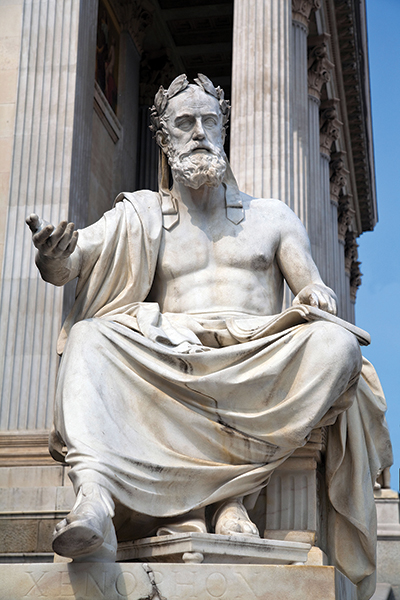
The men first held a council of war in which Xenophon the Athenian came to prominence. Although he had no claim to command, he spoke sensibly and persuasively. Winning the other commanders to his cause, he set proposals before the assembled army. Point by point he elaborated on their current situation, arguing they had more cause for hope than for fear. He recommended they burn everything not useful for fighting or acquiring provisions, swear themselves to redoubled obedience to their commanders, and march for home with a confidence and determination that would daunt their foes. Xenophon would defend the column as head of the rear guard. They must aim at victory, he asserted, for it is the winners who do the killing and the vanquished who perish. The men responded with universal acclamation.
Soon after the Greeks began marching north, Persian slingers, archers and cavalry attacked the rear guard. The Cretan archers could not match the range of the Persians, nor could the hoplites come to grips with their more mobile opponents. After discussing the problem in council, the Greeks organized new units of slingers and a small cavalry corps mounted on packhorses. Time and again on the march they demonstrated similar ingenuity in dealing with challenges. To remain organized at bridges and other chokepoints, they changed their order of march, forming smaller, more flexible units. To put miles between them and the enemy, they practiced deception tactics at night. To seize high ground, they employed small, lightly armed and highly mobile strike forces.
The remaining trek tested the limits of the Greeks’ endurance, as grueling marches through deep snow and biting wind claimed the lives of men and baggage animals alike
When the Greeks entered Corduene (present-day southeast Turkey) and the northern reaches of the Zagros Mountains, they encountered the Carduchians, an independent people who frequently rebelled against the Persians. But events soon dispelled any hope they would allow the Greeks to pass peacefully through their territory. War beacons lit the peaks by night, while daylight hours brought repeated ambushes in narrow passes. From the heights the Carduchians cast down boulders and rained down arrows and sling stones. Again adapting, the Greeks split forces and advanced more cautiously. Hill-hopping, they pushed mutually supporting assaults while carefully guarding their gains until the whole army, including the baggage animals, had passed the chokepoints.
On the eve of leaving Corduene, the Greeks encamped above the plain of the Centrites River, marking the boundary of Armenia. The next morning they woke to find the forces of the Armenian satrap arrayed on the opposite bank to deny their passage. The Greeks attempted to cross, but the river was deep and swift, and the enemy held the high ground on the far side. The Ten Thousand encamped at the river’s edge to consider the problem. Their outlook did not improve when they noted Carduchian troops gathering on the heights behind them. It appeared impossible to either advance or retreat.
The next day brought better news—scouts had discovered a passable ford upriver. After a brief council, the Greeks marched toward it. The Armenians on one bank and Carduchians on the other kept pace with them. En route Xenophon’s rear guard made a feint back downriver, while the main body moved to cross the upper ford under the command of Cheirisophus, a Spartan. Fearing they would be forced to fight on two fronts, the Armenians responded to Xenophon’s feint, weakening their defense enough to allow Cheirisophus to gain a foothold on the far bank. Xenophon then rushed back to join him. At that moment the Carduchians, noting that only a remnant of the Greek army remained on their side, sprang to attack. Xenophon then ordered a charge, retiring across the river the moment the startled enemy had been put to flight.
By this point in the campaign the Greeks had met, defeated and scattered a variety of enemies. Yet they now faced one of their most fearsome foes: winter in the Armenian highlands.
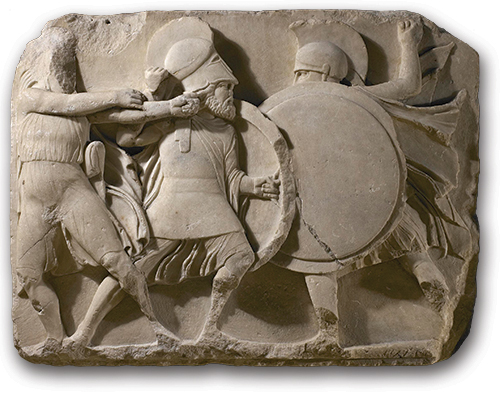
A week into their march through Armenia, the Greeks encountered Tiribazus, governor of the territory through which they passed. He offered a familiar-sounding truce—if the mercenaries refrained from sacking and looting, the Armenians would not attack, and the Greeks could take any supplies they needed. Needing adequate provisions, the Greek leaders accepted, spread the word and resumed the march. Tiribazus’ troops maintained a parallel course about a mile away.
Three days later the Greeks came to a group of villages that provided them with an abundance of meat, vegetables and wine. Distrusting Tiribazus, the army encamped together rather than billeting in separate quarters. That night a heavy snowfall covered the men as they slept on the ground. Rousing with difficulty, they soon restored their blood flow with campfires, exercise and a common ointment made of lard, sesame, bitter almonds and turpentine. However, the chill extended beyond the weather. A scout sent out in the night to investigate suspicious fires soon returned with a prisoner who reported Tiribazus had prepared an ambush for the Greeks in the mountains ahead. Thus forewarned, they launched an attack of their own with a select force, putting the unprepared enemy to flight. The Greeks also captured 20 horses and the governor’s own tent and baggage.
Xenophon was deserving of all praise. To have come so far through so many perils with three-quarters of the army intact was a remarkable military achievement
The remaining trek tested the limits of the Greeks’ endurance, as grueling marches through deep snow and biting wind claimed the lives of men and baggage animals alike. Many troops suffered from starvation and frostbite. Those wearing sandals to bed often woke to find the leather thong had frozen between their toes. Any who lost toes to frostbite or went snow-blind were left behind. Amid such hardships it is not surprising many simply sat down by the side of the road to die. Bringing up the rear, Xenophon did what he could to motivate the men to keep moving and protect them from the enemies at their heels. The army trudged a winding path, searching for a way through the crags and across the rivers that barred their way. They searched for villages where they could rest and eat, imploring guides to point the way forward.
Reaching the final mountain pass that led to the coastal plains below, the Greeks found a sizeable force blocking the way. After consultation they seized the surrounding heights in a swift, disciplined night action, and with the light of dawn the unnerved enemy vanished. Yet challenges remained for the Greeks, as before them lay hundreds of miles of territory inhabited by such tribes as the Taochians, who threw themselves from rocks rather than be captured, and the Chalybes, who carried the heads of fallen enemies as trophies.
On reaching the shore of the Black Sea, the grateful Ten Thousand re-emerged into Greek-populated territory. They spent a month in the Hellenic city of Trapezus, regaining their strength and celebrating bonds forged in hardship with athletic games. Though it seemed an easy matter to acquire ships and sail home, there were not enough vessels to transport the entire army, and the line of march for those remaining afoot was not without obstacles and enemies. Rivalries between citizens of different Greek cities became manifest. Still, Xenophon was deserving of all praise. To have come so far through so many perils with three-quarters of the army intact was a remarkable military achievement.
When Xenophon penned his narrative of the epic march some years later, he could not have predicted its lasting importance. Anabasis of course informed Alexander the Great’s own 4th century BC war against the Persians, but Xenophon’s descriptions of military discipline and decision-making, feints, mountain warfare and rearguard actions remain worthy of study today. Contributing to our understanding of ancient mercenaries, the story of the Ten Thousand stands out as one of the foremost accounts in classical literature describing the day-to-day life of ordinary soldiers. Its portrayal of human tribulation and triumph grants it a timeless appeal. MH
A frequent contributor to Military History, Justin D. Lyons is an associate professor of history and government at Ohio’s Cedarville University. For further reading he recommends Anabasis, by Xenophon; Shadows in the Desert: Ancient Persia at War, by Kaveh Farrokh; and The Greeks at War: From Athens to Alexander, by Philip de Souza, Waldemar Heckel and Lloyd Llewellyn-Jones. This story was published in the September 2020 issue of Military History.

